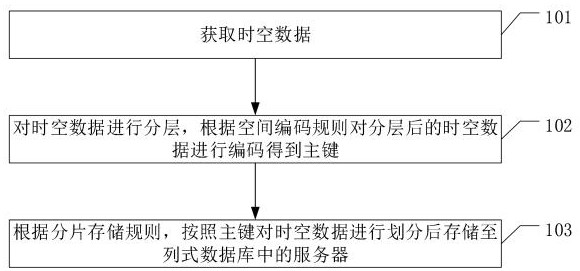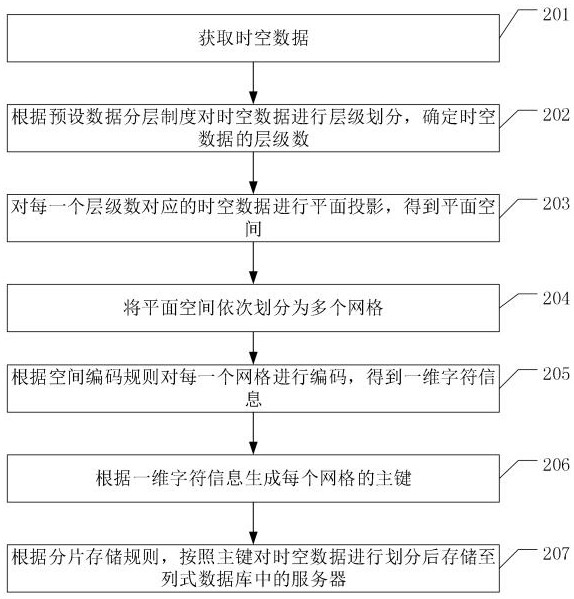Spatial-temporal data management method and system, host and computer readable storage medium
A spatiotemporal data and management method technology, applied in the field of data processing, can solve problems such as insufficient horizontal expansion capability, increased retrieval time, and no consideration of fragmented storage, so as to facilitate index sorting and retrieval, reduce input and output loads, and reduce search results. The effect of address targeting time
- Summary
- Abstract
- Description
- Claims
- Application Information
AI Technical Summary
Problems solved by technology
Method used
Image
Examples
Embodiment 1
[0061] refer to figure 1 , the execution steps of this method include:
[0062] 101. Obtain spatio-temporal data.
[0063] Among them, in the field of geographic information, spatiotemporal data mainly includes vector data and image data.
[0064] 102. Layer the spatio-temporal data, and encode the layered spatio-temporal data according to the spatial coding rules to obtain the primary key.
[0065] Among them, the spatio-temporal data is divided into different precisions and uses, so it is necessary to layer the spatio-temporal data first, and the spatio-temporal data of different levels are encoded using the spatial coding rules to obtain the primary key. Each primary key corresponds to specific spatiotemporal data.
[0066] 103. According to the shard storage rules, the spatio-temporal data is divided according to the primary key and then stored to the server in the columnar database.
[0067] Among them, the columnar database can be a distributed columnar database with...
Embodiment 2
[0070] refer to figure 2 The difference between this embodiment and the above embodiment 1 is that step 102 in embodiment 1 is described in detail, and the specific execution steps include:
[0071] 201. Acquire spatio-temporal data.
[0072] 202. Divide the spatio-temporal data into layers according to the preset data layering system, and determine the number of layers of the spatio-temporal data.
[0073] Among them, the preset data layering system is based on the accuracy and use of spatio-temporal data, and the preset layering judgment principle, for example, the higher the data accuracy, the larger the number of layers. The level number L of spatio-temporal data can be determined by classifying the spatio-temporal data according to the preset data stratification system.
[0074] 203. Perform planar projection on the spatio-temporal data corresponding to each level number to obtain a planar space.
[0075] Wherein, after the spatio-temporal data is layered, the spatio-...
Embodiment 3
[0102] refer to image 3 The difference between this embodiment and the above embodiment 1 and embodiment 2 is that, after completing the spatio-temporal data storage process in the above embodiment, when it is necessary to read the spatio-temporal data from the columnar database, the specific steps include:
[0103] 301. When it is necessary to read the target spatio-temporal data, determine the target level number of the target spatio-temporal data and the corresponding target grid.
[0104] Among them, if the user needs to read the target spatiotemporal data from the columnar database, the target hierarchy number of the target spatiotemporal data and the target spatiotemporal The target grid to which the data corresponds.
[0105] 302. Obtain the target primary key according to the spatial encoding rule, the number of target levels, and the target grid.
[0106] Wherein, combining the generation process of the primary key in Embodiment 2, combining the spatial coding rule...
PUM
 Login to View More
Login to View More Abstract
Description
Claims
Application Information
 Login to View More
Login to View More - R&D
- Intellectual Property
- Life Sciences
- Materials
- Tech Scout
- Unparalleled Data Quality
- Higher Quality Content
- 60% Fewer Hallucinations
Browse by: Latest US Patents, China's latest patents, Technical Efficacy Thesaurus, Application Domain, Technology Topic, Popular Technical Reports.
© 2025 PatSnap. All rights reserved.Legal|Privacy policy|Modern Slavery Act Transparency Statement|Sitemap|About US| Contact US: help@patsnap.com



